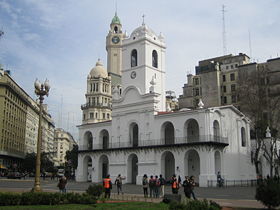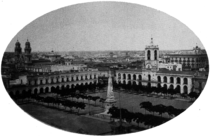
Buenos Aires Cabildo
Encyclopedia

Buenos Aires
Buenos Aires is the capital and largest city of Argentina, and the second-largest metropolitan area in South America, after São Paulo. It is located on the western shore of the estuary of the Río de la Plata, on the southeastern coast of the South American continent...
that was used as seat of the ayuntamiento
Cabildo (council)
For a discussion of the contemporary Spanish and Latin American cabildo, see Ayuntamiento.A cabildo or ayuntamiento was a former Spanish, colonial administrative council that governed a municipality. Cabildos were sometimes appointed, sometimes elected, but were considered to be representative of...
during the colonial times
Spanish colonization of the Americas
Colonial expansion under the Spanish Empire was initiated by the Spanish conquistadores and developed by the Monarchy of Spain through its administrators and missionaries. The motivations for colonial expansion were trade and the spread of the Christian faith through indigenous conversions...
and the government house of the Viceroyalty of the Río de la Plata
Viceroyalty of the Río de la Plata
The Viceroyalty of the Río de la Plata, , was the last and most short-lived Viceroyalty of the Spanish Empire in America.The Viceroyalty was established in 1776 out of several former Viceroyalty of Perú dependencies that mainly extended over the Río de la Plata basin, roughly the present day...
. Today the building is used as a museum.
History

Plaza de Mayo
The Plaza de Mayo is the main square in downtown Buenos Aires, Argentina. It is flanked by Hipólito Yrigoyen, Balcarce, Rivadavia and Bolívar streets....
on March 3, 1608, since the government of the city lacked such a building. Its construction financed with taxes from the port of Buenos Aires, the building was finished in 1610 but was soon found to be too small and had to be expanded.
In 1682, due to lack of maintenance, the building was almost in ruins, and the construction of a new Cabildo with 2 stories and 11 arches wide was planned. Construction of the new building did not start until July 23, 1725, was suspended in 1728, and restarted in 1731. Soon construction was, however, again suspended due to lack of funds. The tower of the new Cabildo was finished in 1764, yet even by the time of the May Revolution
May Revolution
The May Revolution was a week-long series of events that took place from May 18 to 25, 1810, in Buenos Aires, capital of the Viceroyalty of the Río de la Plata, a Spanish colony that included roughly the territories of present-day Argentina, Bolivia, Paraguay and Uruguay...
in 1810 the Cabildo was still not completely finished.
In 1880 the architect Pedro Benoit raised the tower by 10 meters and with a dome covered with glazed tiles, instead of the traditional colonial red tiles. The tower was demolished nine years later in 1889 to create space for the Avenida de Mayo
Avenida de Mayo
Avenida de Mayo , is an avenue in Buenos Aires, capital of Argentina. It connects the Plaza de Mayo with Congressional Plaza, and extends in a west-east direction before merging into Avenida Rivadavia.-History and overview:...
avenue and the three northernmost arches of the original eleven were demolished. In 1931, to create room for the Julio A. Roca avenue, the three southernmost arcs were removed, thereby restoring the central place of the tower, but leaving only five of the original arches.
In 1940, the architect Mario Buschiazzo reconstructed the colonial features of the Cabildo using various original documents. The tower, the red tiles, the iron bars on the windows and the wooden windows and doors were all repaired.
National Museum of the Cabildo
Currently, the Cabildo hosts the National Museum of the Cabildo and the May RevolutionMay Revolution
The May Revolution was a week-long series of events that took place from May 18 to 25, 1810, in Buenos Aires, capital of the Viceroyalty of the Río de la Plata, a Spanish colony that included roughly the territories of present-day Argentina, Bolivia, Paraguay and Uruguay...
(Museo Nacional del Cabildo y la Revolución de Mayo), in which paintings, artifacts, clothes and jewellery of the 18th century are on display. The patio of the Cabildo still has its 1835 ornamental water well.

